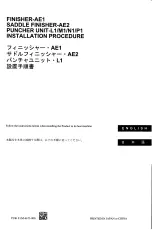
Graphics
Type in and run the following program. Be especially careful to include
both semicolons. The program produces the printout you see below:
10 WIDTH "LPT1:",
255
20 LPRINT CHR$(27)"*"CHR$(32)CHR$(40)CHR$(0);
30
FOR X=1 TO 120
40 LPRINT CHR$(170);
50
NEXT
X
Line 20 selects single-density 24-pin graphics mode (mode 32) and also
reserves 40 columns for graphics. Since 24-pin graphics requires three
bytes of data for
each
column, line 30 begins a loop to supply 120 bytes
of data. Line 40 contains the number 170, which produces the first pin
pattern shown in the section
on
pin labels, and line 50 ends
the
loop.
Designing Your Own Graphics
With
what
you know now, you can use the simplest application of
graphics-calculating by hand
the
data to print the graphic image.
While this method is the most tedious, it helps you understand dot
graphics. It is also useful for small graphic elements that are used many
times.
Software and Graphics
4-15
Summary of Contents for LQ-1010
Page 1: ......
Page 2: ......
Page 148: ...The Cut Sheet Feeder 2 Remove the printer cover 5 18 Using the Printer Options ...
Page 284: ...Appendix Proportional Width Table A 2 Character Tables A 6 A 1 ...
Page 304: ......
Page 308: ......
















































